|
The word "interstitial" means "in-between". So when we refer to "interstitial zones", we are referring
to that which exists between two states of being. In our discussions about intuition, we have referred
to that state of being between being asleep and being awake. And so let's start with that example as
depicted in the diagram.
Sleep / Wakefulness
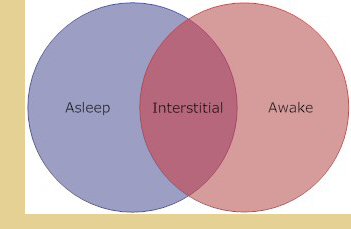 In that in-between state in which we are still partially asleep and just beginning to awaken, we seem to
have the ability to be partially in touch with elements of both states of being, and we can drift back and
forth between the two. There may be remnants of a dream that was part of our sleep-state experience, or
there may be some thoughts or ideas that seem to find their way into our awareness from some unknown place.
So long as we don't focus our conscious mind to sharply on them, they seem to have a life of their own and
sometimes gently lead us other related, or sometimes unrelated, thoughts and ideas.
In that in-between state in which we are still partially asleep and just beginning to awaken, we seem to
have the ability to be partially in touch with elements of both states of being, and we can drift back and
forth between the two. There may be remnants of a dream that was part of our sleep-state experience, or
there may be some thoughts or ideas that seem to find their way into our awareness from some unknown place.
So long as we don't focus our conscious mind to sharply on them, they seem to have a life of their own and
sometimes gently lead us other related, or sometimes unrelated, thoughts and ideas.
In that interstitial state of awareness we seem to know that we can navigate closer to wakefulness, and if
need be, we can move quite quickly to full wakefulness. But in most cases we can also allow our self to drift
back into a state of sleepfulness.
As we are learning to access deeper levels of our intuition, this interstitial zone is rich with possibilities. And
through experience, we can learn to linger in this zone for extended periods of time. The trick is to not lose the
seed-thoughts (intuitive flashes) that percolate out of this in-between state of being. The act of writing them down
or recording them with a voice recorder usually brings us too far over into the wakeful state, making it difficult to
return to the interstitial zone. But we can learn to engage the conscious mind just enough to capture the seed-thoughts
as they arise, and then when we feel we "full", we can gently move into wakefulness and jot down or record keywords so
that we do not lose the thought or idea.
Daylight / Darkness
We will come back to this later, but let's now move on to another example of an interstitial zone. Let's consider the
transition from daylight to darkness (dusk), or darkness to daylight (dawn). One of the characteristics of interstitial
zones is their serendipitous unpredictability. If one had only experienced the fullness of the noonday sun, and the
darkness of the midnight hour, there is no way that one could possibly anticipate the grandeur of a sunset or a sunrise
that can emerge in the interstitial zones between daylight and darkness. The richness of a sunset or a sunrise makes full
daylight or full darkness seem a bit boring by comparison.
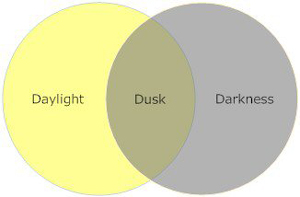
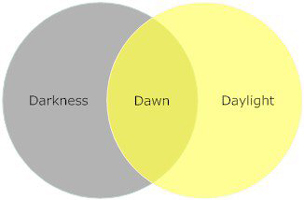
But again, unpredictability seems to reign in these interstitial zones. How many times have we been in a beautiful natural
setting, such as the mountains or at the ocean, and waited at dusk or dawn with camera in hand, ready to capture the glorious
kaleidoscope of colors of a sunset or sunrise? Sometimes our forethought and patients are rewarded, and sometimes there
is not much of a show. Or on the other hand, how many times have we been preoccupied with activity as dusk approaches,
and suddenly the sky breaks out in the magnificence of a color and light show? Or the same possibility at dawn?
It is almost impossible to predict.
We are affected by the transition from daylight to darkness, or vice versa, in other ways as well. The Earth energies
tend to be more magnetic in nature at dawn, and more electric at dusk. Our feelings and emotions tend to resonate more
with magnetic energies, while our thoughts tend to be more electric in nature. Consequently, the interstitial zone that
we call dusk is more conducive to insightful mental activity, while dawn provides us an opportunity to delve more deeply
into our feelings and emotions.
With this in mind, let me describe a process that one of my mentors, Dr. Derald Langham, shared with me. He was involved
with a small group of people who got together fairly regularly to explore various aspects of science or philosophy,
reminiscent of the days of Plato and Socrates. He was aware of the potential of interstitial zones, and over time evolved
a process to capture the richness of the zone between daylight and darkness. The group would meet at his home about an hour
before dusk, and begin to have a conversation. They would leave all of the lights in his home turned off, so there was only
the diminishing daylight coming in from the outside. As dusk gently enfolded the group, the conversation began to grow
richer, eventually continuing on in full darkness. There were other interstitial-related principles that they incorporated
into the process, such as the zone between talking and silence. In so much of our contemporary conversation, people become
uncomfortable if there are long pauses in conversation. But by encouraging periods of silence within the structure of the
group conversation, it provides a fertile environment for new and insightful ideas to emerge.
Internalization / Externalization
Let's consider yet another interstitial zone. In most meditation techniques we are taught to turn our focus inward. This
implies that we minimize sensory input, so we close our eyes and meditate in the stillness of a quite place. However, if
we can learn to be in a state of "soft awareness" of gentle sounds or perhaps aromas that come to us from our external
environment, without focusing on them, they can add to the richness of our meditative experience. Again, an example may be helpful.
For several years I lived right on the edge of Elliott Bay, on Alki Point, in Seattle. I normally sleep with windows open,
and as I would begin to awaken in the morning, quite often I would hear the gentle lapping of the water against the shoreline.
And then there would also be the occasional cawing of a seagull in the distance. And the breeze coming off of the salt water
carried with it the distinctive aroma of the sea. As I would linger in the interstitial zone between sleepfulness and
wakefulness . . . just being aware of, but not focusing on these gentle sounds and scents . . . they seemed to enhance the
richness of my interstitial experience. Rather than perceiving these sensory inputs from the external world as unwanted
intrusions into my internal world, I found myself welcoming them into my experience in this in-between zone.
Seasons
As one begins to relate to life more and more in terms of interstitial zones, we start to see them everywhere! For
example, instead of thinking of the annual cycles as consisting of the four seasons . . . winter, spring, summer
and autumn . . . we might think just of the two extremes: winter, the peak of dormancy and bleakness, and summer,
the peak of fullness of nature. And then spring becomes simply the interstitial zone between winter and summer,
and autumn the interstitial zone between summer and winter.
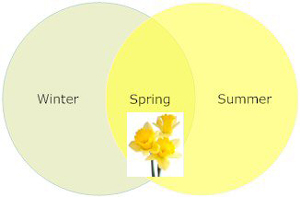
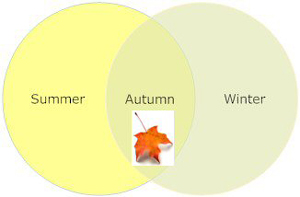
And just as a beautiful sunrise is a peak experience
between darkness and daylight, so also the "interstitial zone" that we call spring, with new growth and blossoms
springing forth everywhere, is a peak experience between winter and summer. And similarity, the magnificence of
autumn colors exemplifies the interstitial zone between summer and winter.
Land / Water . . . Plains / Mountains
So also, we could think of a seashore or lakeshore as an interstitial zone between land and water. Isn't it interesting
that people are drawn to live in such zones. If we had never seen a coastal area, but had only seen the flat lands of
Nebraska and the middle of an ocean, it would be almost impossible to imagine the magnificence and unpredictable variations
of the borderland (interstitial zone) between land and ocean.
Likewise, one finds relatively few people living on the flat plains of eastern Colorado, or in the ruggedness of the
Colorado Rockies, but millions of people are drawn to live where the plains and mountains meet . . . along the
so-called "front range" that extends from Colorado Springs on the south, to Fort Collins on the north. What is it
about our inherent nature that draws us to such interstitial zones?
The Dynamics of 3-ness
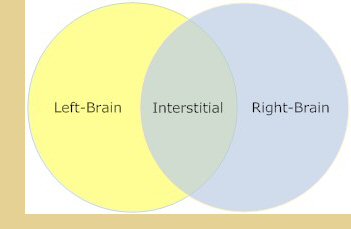 A few decades ago there was much interest in the differences between the way our right-brain functions compared to
our left brain. Many studies were done to delineate the characteristics and functioning of each Cerebral hemisphere.
Since the educational systems in the western world tend to focus mostly on left-brain types of cognitive learning,
there arose considerable interest in developing techniques to help people achieve a more even balance between their
left-brain and right-brain thinking processes. Again, we might look at this in terms of learning ways to spend more
of our time in the interstitial zone between left-brain and right-brain activity.
A few decades ago there was much interest in the differences between the way our right-brain functions compared to
our left brain. Many studies were done to delineate the characteristics and functioning of each Cerebral hemisphere.
Since the educational systems in the western world tend to focus mostly on left-brain types of cognitive learning,
there arose considerable interest in developing techniques to help people achieve a more even balance between their
left-brain and right-brain thinking processes. Again, we might look at this in terms of learning ways to spend more
of our time in the interstitial zone between left-brain and right-brain activity.
With the emergence of the awareness that there is a so-called "heart-brain", as we discussed in the "Life 101" module,
a third element has now been introduced into our thinking models. If we consider this model in terms of interstitial zones,
we realize that in addition to the interstitial zone between the left-brain and right-brain, there is also an interstitial
zone between the left-brain and the heart-brain, and another such zone between the right-brain and heart-brain. This is
depicted in the diagram. In the very center is an area we have labeled "Dynamic Center".
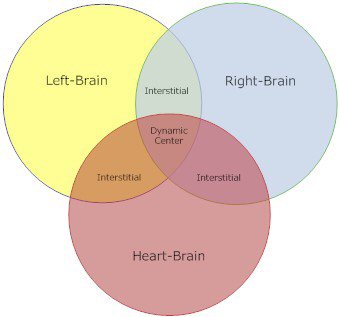
This dynamic center represents an interstitial zone consisting of three aspects, rather than two.
Much of life in the natural world involves an interplay between 3 variables. For example, in electricity, Ohm's law
defines the relationship between voltage, resistance and current. Thermodynamics involves the relationship between
pressure, temperature and volume. The dynamics of plant growth involves an interplay of moisture, temperature and
light. In the mechanics of motion, force equals mass times acceleration.
Nikola Tesla, who invented ways to generate and utilize alternating current (AC), in contrast to direct current (DC), designed
the 3-phase system that is still the standard for today's commercial electrical systems. Using this system, he was able
to create a rotating electromagnetic induction field that is used in electric motors and generators. Again, it is the
"3-ness" that enables the dynamic motion.
So when we are dealing interstitial zones that involve 3 aspects, rather than two, the combined interstitial zones
involve a much more dynamic environment.
The Science of Interstitial Zones
A brief discussion of the science that is involved with interstitial zones may be helpful. For the purpose of
contrast, let's start with the concept of binary logic, upon which virtually all of today's digital computers are
based. In binary logic, only one of two states can exist . . . "on" or "off". This is just like a normal light
switch that we have in our homes. In reference to the interstitial diagrams we have using, it would be like two
circles that touch each other, but which do not overlap. For example in the "awake" or "asleep" situation, if we
are sleeping soundly, and a loud alarm clock goes off, we shift immediately to the "awake" state . . . there is no in-between.
In contrast to binary logic, let's consider analog logic, sometimes referred to as "fuzzy" logic. Analog logic is based
on the concept of "gradations". Going back to the analogy of a light switch in our home, analog logic is
like a "dimmer" switch . . . the light can be not only just off or on, but there are many "gradations" in-between, ranging
from very dim to very bright.
Interstitial zones are gradational by their very nature . . . partly one thing, partly another. And
it is the "partly" aspect that makes them so unpredictable.
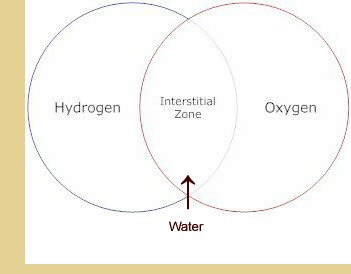 Consider water, for example. Let's say that we didn't know anything about what water is made of. But let's
also say that we knew a lot about hydrogen and a lot about oxygen. For purposes of illustration, we could
set up an interstitial diagram for hydrogen and oxygen as shown below.
Consider water, for example. Let's say that we didn't know anything about what water is made of. But let's
also say that we knew a lot about hydrogen and a lot about oxygen. For purposes of illustration, we could
set up an interstitial diagram for hydrogen and oxygen as shown below.
Within the interstitial zone between hydrogen and oxygen, most of the partly-hydrogen / partly-oxygen combinations
would not yield anything of significant interest. However, at some specific point within the interstitial zone that
involved the precise proportions and configurations of hydrogen and oxygen, water would be the result. In looking at
the characteristics of hydrogen and the characteristics of oxygen, there is no way that one would be able to predict that
by combining them in just the right proportions and configuration, water would be the result. As we know, water has
absolutely no similarities to either hydrogen or oxygen.
Chaos theory is an attempt to deal with the idea that slight variations in initial conditions of variables in a dynamic
system produce widely unpredictable results. If we think of an interstitial zone as being dominated by chaos, then the
idea of a "holon" also comes into play. A holon is defined as a stable sub-set, or hybrid sub-part of a greater whole.
In this sense, an integral idea that emerges as an intuitive flash from within the interstitial zone between sleep and
wakefulness could perhaps be considered to be a holon that emerges from within a field of chaos.
Regardless of the theories and the mathematics that may be involved, the dominate characteristic of interstitial zones
is their unpredictability, and therefore their importance as a seedbed for creativity.
The "Grandmother" of All Interstitial Zones!
In the module entitled "2012 - A Perspective", we discussed the concept of a "New Earth" that is in the process
of formation. We used the analogy of cell "mitosis", in which one cell splits into two cells. Although no one
is quite sure how the eventual split between the Old Earth and the New Earth will take place, it does seem that at
the present time there is an overlap between the two worlds that is characteristic of an interstitial zone. Those who
have chosen the path of ascension are in the process of moving into full alignment with the New Earth, and will ascend
with her as the final split between the two worlds takes place.
A few years ago Gregg Braden wrote a book entitled, Walking Between the Worlds. Although the primary focus of the book
is about compassion, we believe it also resonates with the idea of living within an interstitial zone in which
some people are more aligned with the Old Earth, and others more aligned with the New Earth.
Alignment with the Old or with the New is dependent on what we put our focus on. Are we focused on the fear-based
paradigms of the old Earth, or are we focused on, and living in alignment with, the love-based paradigms
of the New? The choice is up to each of us.
|

